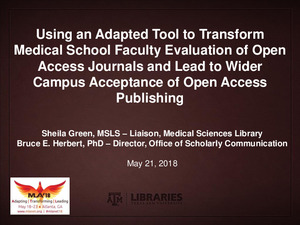| dc.creator | Green, Sheila W | |
| dc.creator | Herbert, Bruce E. | |
| dc.date.accessioned | 2018-05-17T19:15:38Z | |
| dc.date.available | 2018-05-17T19:15:38Z | |
| dc.date.issued | 2018-05-21 | |
| dc.identifier.citation | Green, Sheila W; Herbert, Bruce E. "Using an Adapted Tool to Transform Medical School Faculty Evaluation of Open Access Journals and Lead to Wider Campus Acceptance of Open Access Publishing." Paper presented at Medical Library Association Annual Meeting, Atlanta, GA, May 21, 2018. | en |
| dc.identifier.uri | https://hdl.handle.net/1969.1/166414 | |
| dc.description.abstract | Objective: To share how an adaptation of the Association of American Medical Colleges (AAMC) Annotated bibliography of journals for educational scholarship is being transformed into a program to facilitate medical faculty assessment of open access (OA) journals, and is enabling librarians to lead open access evaluation for faculty on the main campus. Methods: A companion reference chart indicating MEDLINE indexing, journal impact quartile rankings, and open access and/or self-archiving policy was adapted from the Association of American Medical Colleges (AAMC) Annotated bibliography of journals for educational scholarship and made freely available in April 2017. This chart has been downloaded from the institutional repository over 800 times. Scholarly communications leadership saw this format as an opportunity to overcome “predatory journal” anxiety that many faculty face when considering open access journals for publication. A pilot project with a medical school research team was developed to identify and supply open access journal quality criteria for journals relevant to the team’s research and publishing goals. After an initial proof-of-concept demonstration to the lab director, criteria and subject areas were refined, and a new journal reference chart prepared. Faculty will have a tool for both subscription and open access journal selection that is not only relevant to their research area but also sends a positive message about the potential of OA publication. Results: Outreach efforts to labs, centers and departments are ongoing and impact is measured by changes in the number of applications to the institution’s fund to subsidize OA author fees. Main campus subject librarians have formed a working group to tailor the process and format for their client groups. Conclusion: While every discipline has unique norms of publication, all faculty want common assurance about the quality and impact likelihood of the venue in which they publish. Librarians can lead faculty to data-driven decision-making by adapting and consolidating existing tools into easy-to-use reference sheets and transforming the OA landscape from predatory to inviting. | en |
| dc.language.iso | en_US | |
| dc.rights | Attribution-NonCommercial-ShareAlike 3.0 United States | en |
| dc.rights.uri | http://creativecommons.org/licenses/by-nc-sa/3.0/us/ | |
| dc.subject | Scholarly communications | en |
| dc.subject | Open Access | en |
| dc.subject | Journal Selection | en |
| dc.subject | Journal quality | en |
| dc.title | Using an Adapted Tool to Transform Medical School Faculty Evaluation of Open Access Journals and Lead to Wider Campus Acceptance of Open Access Publishing | en |
| dc.type | Presentation | en |
| local.department | University Libraries | en |



